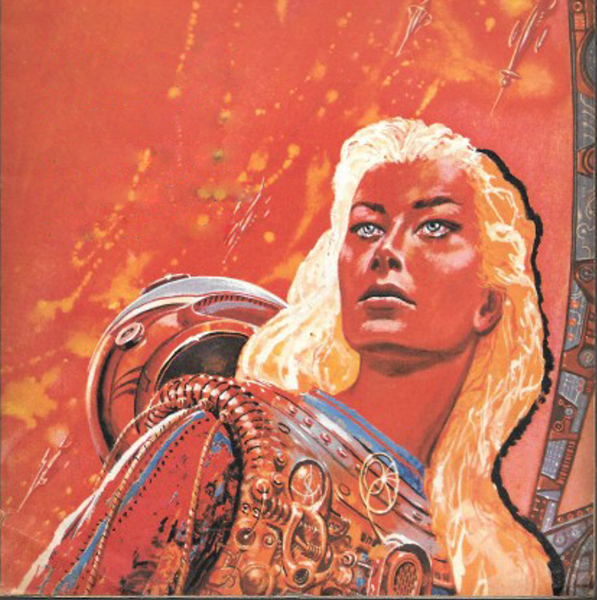Lost in Time

It’s Women’s History Month! And to kick it off, our article today is on the unsung women science fiction and fantasy authors of yesteryear.
Pop quiz: How many pre-1980 woman science fiction authors can you name? If you’re like most people I’ve asked this question of, Ursula K. Le Guin comes springing to your lips. Octavia Butler. James Tiptree Jr (aka Alice Bradley Sheldon). Maybe you’re aware of Andre (Alice) Norton and Leigh Brackett. Anne McCaffrey. Joanna Russ.
If you’re like the aforementioned recipients of this question, you may start to draw blanks. You might know that Mary Shelley started the genre with Frankenstein, but the hundred and fifty years between Shelley and Le Guin is a haze. Were there women writing science fiction in the 20s, 30s, 40s, and 50s?
There are many answers to this question, so I’ll start with the binary one. Yes. When Le Guin came on the scene with her lovely 1962 story, April in Paris, there were in fact more than thirty women writing and publishing science fiction.
And not just sidelined folks in lesser publications. We’re talking names that were big at the time: Katherine MacLean, Margaret St. Clair (also writing as Idris Seabright), Kate Wilhelm, Mildred Clingerman, Miriam Allen deFord, Otis Kidwell Burger, S. (Sonya) Dorman, Doris Pitkin Buck, J. (Joan) Hunter Holly, Zenna Henderson, Evelyn Smith, C.L. Moore… In 1958, three of the six “Best New Authors” on the Hugo ballot were women: Kit Reed, Rosel George Brown, and Pauline Ashwell.

Kit Reed 
Rosel George Brown 
Illustration from Pauline Ashwell’s ‘Unwillingly to School’
Then there are all the one/two/three hit wonders who wrote a handful of lovely stories and then disappeared into other pursuits.
In the course of reading everything that came out in the 1950s and 60s, as part of my Galactic Journey through time, I rediscovered all these amazing authors. I found myself craving stories written by women: they tended to be different, more nuanced, certainly from a non-standard (i.e. male) perspective.
Here is the “Second Sex in SFF” series I wrote with brief biographies of most of the women writing SF that I encountered via the Journey. It’s a great jumping off point if you want to rediscover some amazingly talented writers.

Unequal Partners in Wonder
Now, on the one hand it is true that women have always been vital contributors to the genre, both as professionals and as fans. It would be disingenuous, however, to suggest that because there were some women participating in the genre there were no barriers to their participation in the genre (as has been argued vociferously by some).
The fact is that such barriers were legion, even if they were not fully articulated. Yes, it’s true that one of the premiere science fiction editors of the late 50s/early 60s was a woman (Cele Goldsmith). Yes, it’s true that John W. Campbell of Astounding and H. L. Gold of Galaxy, and especially Anthony Boucher of Fantasy and Science Fiction, discovered and touted their female finds.
However, it is also true that, until the mainstreaming of female participation in the 1970s (thanks in part to Star Trek), women authors wrote about 5-10% of the SFF that got published. Women often hid behind initials or masculine names: Katherine MacLean submitted her first story to Astounding as “K. MacLean” because her family told her that science fiction didn’t publish women. Sidney van Scyoc had a male-identifying name to hide behind. Sonya Dorman didn’t reveal her gender until 1966, half a decade into her career. Whether was active discrimination on the editorial side or passive discrimination that caused woman authors to self-censor, women were far from “equal partners.”
This prejudice has caused women’s works before a certain date to disappear from the public ken for two reasons. One is that there just wasn’t as much of it, so there was less of it to survive. The other is, as junior partners, their work was valued less compared to the prolific masters of the day: the Heinleins, the Asimovs, the Clarkes.
Raison d’etre
It is not hyperbole to say that Journey Press was founded to bring these forgotten authors back into the spotlight. Rediscovery: Science Fiction by Women (1958-1953) was a labor of love, and we’ve been blown away at the tremendous response it has received. We’re already hard at work on the second Rediscovery, which will cover 1952-1957. It’s an ambitious project, and we’ve teamed up with Dr. Lisa Yaszek, editor of Library of America’s The Future is Female to ensure we find the best stories of the era. We know you will enjoy the volume when it comes out next March.
But in the meantime, between the first Rediscovery, The Future is Female, and the Second Sex in SFF series, you have a wealth of authors to discover and love. And there’s no better opportunity to do it than this month. Enjoy, and please let us know your favorites!

